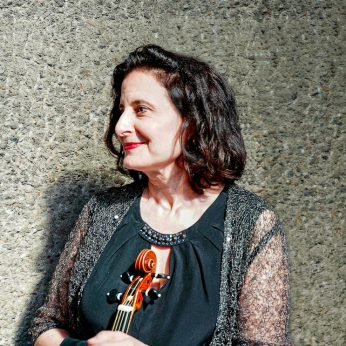Composer: Francesco Buonaporte (b. 1672 - d. 1749)
Performance date: 30/06/2023
Venue: St. Brendan’s Church
Duration: 00:08:15
Recording Engineer: Gar Duffy, RTÉ
Instrumentation: vn, hpd
Instrumentation Category:Duo
Artists:
Ariadne Daskalakis -
[Violin]
Michael Borgstede -
[Harpsicord]

Aria(Cantabile)
Allegro-Giga( Allegro)
Recit
Bazaria Andante
Most of the composers from today’s concert programme were writing in the later Baroque period in the shadow of Monteverdi. Another influential master who preceded our concert’s featured composers was the composer and virtuoso violinist Anchangelo Corelli, with whom both Geminiani and Vivaldi studied and who also influenced for Handel. Corelli is accredited to making a major contribution to the chamber music style and form of the Late Baroque era, including the publishing of five books of violin sonatas. In the repertoire performed we see a display of Italian Baroque features such as extensive ornamentation, more expressive harmony and a clearer polarity between melody and baseline than had been heard in the Renaissance era.
We first hear from Buonaporte, this June being the 350th anniversary of his birth in Northern Italy. He was a priest and a composer who had studied theology and composition in Rome. His Inventione in A major opens with a lyrical violin melody in the cantabile Aria, followed by a combination of recitative and faster movements. The fastest passages are extremely intricate, with ornamentation and frequent double stops, yet regardless of speed each retains distinct character- the second theme from the closing Bazaria Andante being particularly infectious to the ear. Geminiani was born in Tuscany in 1687 and was a gifted violin player as well as composer who lived and worked for a time in both London and Dublin around the 1730’s. His Sonata in C minor displays notably dissonant points of suspension in its opening Grave movement, with energetic, intricate Allegro movements to follow with sequence used as a recurring feature.
Luigi Boccherini who was writing slightly later, in the early classical era, composing this Op.5 Sonatas in 1768 at the age of 25. Having recently moved to Paris, his work Six Sonatas for Harpsichord and Violin, apparently arose from his contact with the French harpsichordist Madame Brillon de Jouy. Madame Brillon apparently hosted regular performances in her Parisian home- to which her neighbour Bemjamin Franklin was a regular guest during his time in Paris. We can hear change in style here from the elaborate, ornate melodies of the previous two composers. Although this piece was written in the early classical era( 1768) from the opening Andante movement we hear a sense of the balance and symmetry of the classical style, with simpler melodic phrases that at times follow a call and response pattern. The violin also begins to share more of the melodic material with the harpsichord.
Following Boccherini, we hear from our only non-Italian composer of the programme, George Frideric Handel. However, while being born in Germany and working the majority of his life in London, Handel also spent a number of years working in Italy in his twenties, meeting and working with prominent Italian composers such as the Scarlattis and Archangelo Corelli who had an influence on his compositional style. His Sonata in A Major is slightly different to what we have heard in Bonaparti and Geminiani’s decorative writing. While his slower movements have a calm, legato feel not so totally different from the latter two composers’, the contrast is heard in his two Allegro movements which have simpler, less heavily ornamented melodies and are slower paced than the Italian equivalents.
Antonio Vivaldi, however, provides a suitably ornate and virtuosic end to our programme. A renowned violin player, Vivaldi was taught by his father Giovanni Battista who played in the orchestra of the San Marco Basilica in Venice and as well as being a composer Vivaldi was also an ordained priest. His fast movements demonstrate the influence of his own incredible command of the violin on his writing style, heard for example in the descending arpeggiated passages of the Corrente, or the incredibly fast compound time quavers of the Giga.
Ruah Pearson
Copyright © 2025 West Cork Music. All rights reserved.
Designed and developed by Matrix Internet